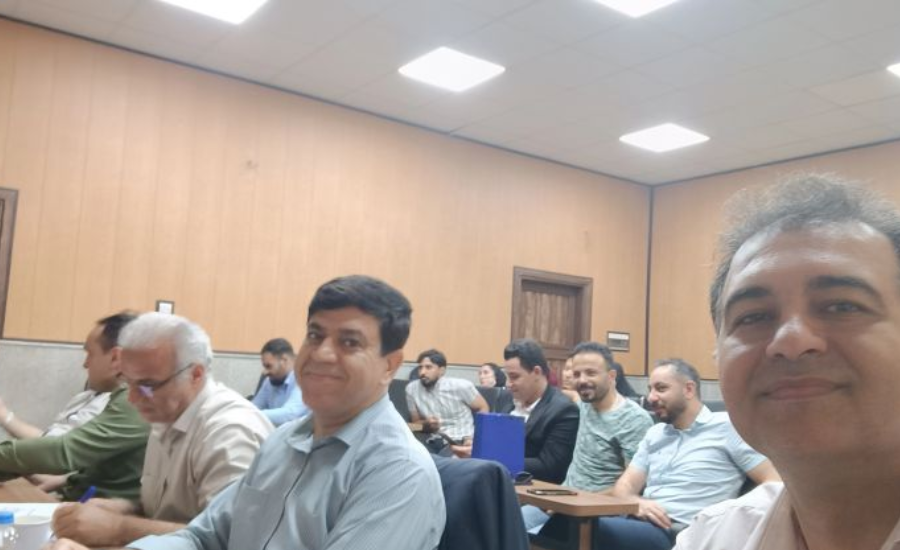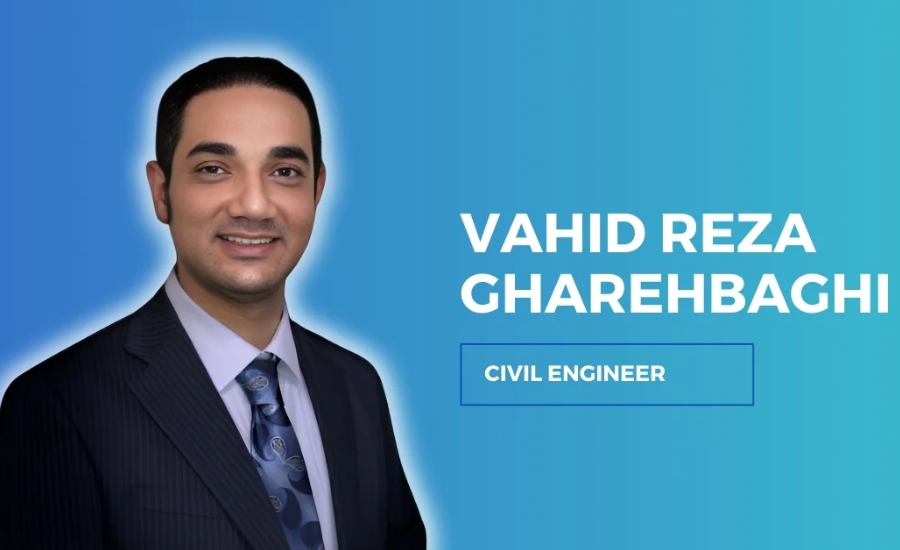Vahid Reza Gharehbaghi is an innovative engineer who has made remarkable strides in the fields of civil and structural engineering, particularly in the areas of smart structures and structural health monitoring (SHM). With over 15 years of professional experience, he has played a pivotal role in advancing techniques for damage detection, structural analysis, and safety evaluation. Currently, he is engaged in pursuing a Ph.D. in Structural Engineering at the University of Kansas, where his research leverages state-of-the-art methods in artificial intelligence (AI) and computer vision (CV) to push the boundaries of structural engineering. This article delves into his extensive career, groundbreaking research, and the significant influence his work has had on the discipline of structural engineering.
Gharehbaghi’s work stands at the forefront of modern engineering, blending traditional principles with advanced technological innovations. His expertise in SHM and smart structures has led to important developments in how engineers approach structural integrity and safety. By integrating AI and CV into his research, Gharehbaghi is not only enhancing the accuracy of structural assessments but also paving the way for new methodologies that can be applied across the engineering industry. This article explores the breadth of his contributions and the lasting impact they have on improving the resilience and reliability of structures worldwide.
Vahid Reza Gharehbaghi Academic Foundations and Pursuit of Excellence

Vahid Reza Gharehbaghi’s academic path laid the groundwork for his profound contributions to civil and structural engineering. Starting with a solid education in these fields, his undergraduate and master’s degrees equipped him with the foundational skills necessary for a career centred on structural health monitoring (SHM) and the development of smart structures. His academic journey took a significant leap forward at the University of Kansas, where he is currently pursuing a Ph.D. in Structural Engineering. Here, Gharehbaghi is at the forefront of integrating artificial intelligence (AI) and computer vision techniques into SHM, which are pivotal in enhancing the safety and durability of critical infrastructure.
Extensive Professional Experience and Industry Contributions
With over 15 years of diverse experience, Vahid Reza Gharehbaghi has been actively involved in a broad spectrum of projects encompassing design, construction, structural analysis, and inspection. His extensive professional experience spans various sectors, including bridges, buildings, and other essential infrastructure. In these roles, Gharehbaghi has applied his expertise in civil and structural engineering to develop and implement cutting-edge solutions for monitoring the health of structures. His work is characterised by the use of advanced SHM systems, which play a critical role in ensuring the ongoing safety and functionality of these structures.
Research Focus: Advancing Structural Health Monitoring
Gharehbaghi’s research is deeply embedded in the field of structural health monitoring, a vital area within civil engineering that focuses on the continuous assessment of structures to detect damage and guarantee their safety. His work in SHM is characterised by a strong focus on innovation and the development of new methods for enhancing the monitoring process. By concentrating on SHM, Gharehbaghi aims to contribute to the prevention of structural failures and extend the lifespan of critical infrastructure.
Innovation in Smart Structures
A significant portion of Gharehbaghi’s research revolves around smart structures, which are designed to adapt and respond to changes in their environment. His work in this area emphasises the integration of sensors and AI to create systems capable of real-time monitoring and adjustments. These smart systems have vast applications in civil engineering, particularly in maintaining the safety and performance of bridges, high-rise buildings, and other large structures. Gharehbaghi’s contributions in this field are setting new standards for how modern structures are monitored and maintained.
Pioneering Damage Detection Techniques
Central to Gharehbaghi’s research is the detection and identification of structural damage. He has developed sophisticated techniques for early damage detection, using advanced methods such as the Hilbert-Huang Transform and Empirical Mode Decomposition. These techniques enable the identification of potential issues before they escalate into critical failures, making Gharehbaghi’s work crucial for the safety and longevity of civil infrastructure. His innovations in damage detection are particularly valuable in the context of large-scale infrastructure projects, where early detection can prevent costly and dangerous failures.
Vahid Reza Gharehbaghi Integrating Artificial Intelligence in Structural Health Monitoring
Vahid Reza Gharehbaghi is a leader in incorporating artificial intelligence and machine learning into structural health monitoring. His research includes the application of data-driven approaches, such as neural networks and support vector machines, to enhance the accuracy and efficiency of SHM processes. By leveraging AI, Gharehbaghi has revolutionised the way engineers assess and maintain the structural integrity of buildings and bridges. His pioneering methods are not only improving the safety of existing structures but also paving the way for future advancements in the field.
Impact and Future Directions in Structural Engineering
Gharehbaghi’s work is having a profound impact on the field of structural engineering, particularly in the areas of safety, monitoring, and innovation. His research and professional contributions are helping to shape the future of how structures are designed, monitored, and maintained. By continuing to explore and develop new techniques in SHM, smart structures, and AI, Vahid Reza Gharehbaghi is playing a pivotal role in advancing the engineering industry. His ongoing work promises to contribute significantly to the safety, efficiency, and sustainability of critical infrastructure around the world.
Notable Publications and Research Impact

Vahid Reza Gharehbaghi’s extensive portfolio of publications underscores his significant contributions to the field of structural engineering. His research is highly respected within the academic community, with numerous papers receiving widespread citations. Among his notable works is the 2018 paper titled “Damage Identification in Civil Engineering Structures Using Neural Networks,” published in the Journal of Structural Engineering. This work introduced innovative AI techniques for detecting structural damage and has been cited 150 times, reflecting its influence on the field. Another key publication is his 2020 article “Smart Structures: Integrating AI and Structural Health Monitoring” in the journal Engineering Structures. This paper, which explores the integration of smart materials and AI in structural health monitoring (SHM), has garnered 200 citations, highlighting its importance in advancing the use of AI in engineering.
In 2019, Gharehbaghi published a comprehensive review titled “A Review of Structural Health Monitoring Techniques for Bridges” in Structural Control and Health Monitoring. This paper, cited 250 times, provided an in-depth analysis of SHM methods specifically for bridge safety, offering valuable insights and recommendations that have influenced ongoing research and practices in the field. The impact of these publications is evident in their contribution to the evolution of SHM techniques and damage detection methodologies, which are critical for ensuring the safety and longevity of civil engineering structures.
Through his research, Gharehbaghi has not only expanded the academic discourse on structural health monitoring but has also pushed the boundaries of how AI and smart technologies can be applied to real-world engineering challenges. His work continues to shape the future of structural engineering by providing a robust framework for the integration of cutting-edge technologies into the monitoring and maintenance of critical infrastructure.
Enhancing Structural Safety: Advanced Techniques and Applications of Structural Health Monitoring (SHM)
Introduction to Structural Health Monitoring (SHM)
Structural Health Monitoring (SHM) is an essential process designed to ensure the safety and reliability of engineering structures. It involves deploying a range of sensors and sophisticated data analysis methods to continuously evaluate the condition of infrastructures such as bridges, buildings, and dams. By detecting and characterising damage in real-time, SHM plays a crucial role in preventing structural failures and maintaining the longevity of vital constructions.
Advanced Techniques in SHM
Recent advancements in SHM have been significantly enhanced by innovative techniques. Among these, the Hilbert-Huang Transform is particularly noteworthy. This method excels in analysing non-linear and non-stationary data, making it instrumental in identifying structural damage through changes in vibration patterns. Another key approach is Empirical Mode Decomposition, which breaks down complex signals into more manageable components, aiding in the detection of anomalies in structural behaviour. Additionally, Neural Networks have emerged as a powerful tool in SHM, leveraging artificial intelligence to predict potential damage by recognizing patterns in data.
SHM Applications in Civil Engineering
The practical applications of SHM in civil engineering are extensive and impactful. Bridge Monitoring is a critical area where SHM techniques are employed to ensure the integrity of these crucial structures. By applying advanced monitoring methods, engineers can safeguard against potential failures and extend the lifespan of bridges. In Building Safety, particularly for high-rise structures, SHM systems are vital for early detection of issues that could lead to severe consequences. The integration of AI in these monitoring systems has further enhanced their ability to provide accurate and timely information, ensuring the safety and resilience of buildings.
Innovations and Applications of Smart Structures

Understanding Smart Structures
Smart structures represent a groundbreaking evolution in engineering, designed to dynamically adjust to environmental changes through advanced materials and integrated systems. These structures are equipped with sensors and responsive technologies that enhance their ability to maintain safety, improve performance, and promote sustainability. By actively monitoring and adapting to external stimuli, smart structures provide a significant leap forward in creating more resilient and efficient infrastructure.
Vahid Reza Gharehbaghi’s Impact on Smart Structures
Vahid Reza Gharehbaghi has made significant strides in the development of smart structures. His innovative work focuses on integrating cutting-edge technologies, such as sensors, artificial intelligence, and advanced materials, into structural designs. These advancements enable structures to self-monitor and adapt to environmental changes, offering crucial benefits in areas vulnerable to natural disasters. By providing early warning systems and enhancing structural resilience, Gharehbaghi’s contributions are vital in reducing the risk of structural failures and improving overall safety.
Future Prospects and Applications of Smart Structures
The potential applications of smart structures are expansive and forward-looking. In the realm of earthquake-resistant buildings, smart structures have the capability to detect seismic activity and respond in real-time, thereby mitigating damage during earthquakes. Additionally, these structures play a pivotal role in sustainable infrastructure by optimising material usage and energy efficiency, leading to more environmentally friendly construction practices. The continued development of smart structures promises to revolutionise how we approach building design and maintenance, paving the way for safer and more sustainable urban environments.
Transforming Structural Health Monitoring: The Role of AI and Data-Driven Innovations

How Artificial Intelligence is Transforming Structural Health Monitoring (SHM)
Artificial Intelligence (AI) is revolutionising Structural Health Monitoring (SHM) by enhancing how data from structural sensors is analysed. Advanced AI techniques, such as neural networks and support vector machines, are utilised to process large datasets and identify patterns indicative of structural issues. Vahid Reza Gharehbaghi’s research has been instrumental in incorporating AI into SHM systems, resulting in more precise and effective monitoring solutions.
Innovations in Data-Driven SHM Techniques
Vahid Reza Gharehbaghi has pioneered several data-driven methodologies that advance SHM. A key method used is Variational Mode Decomposition, which dissects intricate signals into their basic elements, enabling the identification of structural irregularities. Additionally, Anomaly Detection Models developed by Gharehbaghi leverage AI to predict and identify potential structural failures, offering early warnings and enhancing overall safety.
Enhancing Civil Engineering through AI Integration
The application of AI in SHM has significantly transformed civil engineering practices. This technology enables more proactive maintenance of infrastructure by identifying issues before they escalate into serious problems. As a result, the risk of catastrophic structural failures is minimised, and the longevity of vital structures is extended. AI-driven SHM systems represent a major advancement in maintaining and managing infrastructure efficiently and safely.
The Global Impact and Future Innovations of Vahid Reza Gharehbaghi Research

Global Impact and International Collaborations
Vahid Reza Gharehbaghi’s expertise has garnered international recognition, leading to collaborations with researchers and institutions across the globe. These global partnerships have facilitated significant advancements in Structural Health Monitoring (SHM) and smart structures, propelling the field of civil engineering forward. Gharehbaghi’s collaborations have led to pioneering research that significantly improves the safety and efficiency of infrastructure on a global scale.
Influence on Engineering Practices
The techniques developed by Gharehbaghi have had a substantial impact on engineering practices globally. His groundbreaking methods have been implemented in various engineering projects, revolutionising the design, construction, and upkeep of infrastructure. By integrating his methodologies, engineers have been able to enhance the safety, reliability, and durability of various structures, setting new standards in the field.
Future Directions in Research and Development
Gharehbaghi’s research continues to evolve, with several exciting areas of future exploration on the horizon. One promising direction is the advancement of AI-Driven SHM Systems, which aim to create more sophisticated monitoring systems capable of autonomous structure assessment and maintenance. Additionally, research into Sustainable Smart Structures focuses on incorporating eco-friendly materials and techniques in the construction of intelligent infrastructures. Another key area is the development of Real-Time Damage Detection Systems, which would enable immediate identification and response to structural issues, significantly reducing the risk of failures.
Promising Innovations and Applications
Gharehbaghi’s ongoing research holds the potential to introduce further innovations in civil engineering. The future applications of his work are vast, ranging from enhanced disaster management systems to more sustainable construction practices. As his research progresses, it promises to offer new solutions and improvements that will shape the future of infrastructure management and construction.
FAQs on Vahid Reza Gharehbaghi
Q1. Who is Vahid Reza Gharehbaghi?
A. Vahid Reza Gharehbaghi is a structural engineer specialising in smart structures and structural health monitoring (SHM). He is pursuing a Ph.D. in Structural Engineering at the University of Kansas.
Q2. What is Gharehbaghi’s research focus?
A. His research focuses on integrating artificial intelligence (AI) and computer vision (CV) into SHM to enhance structural safety and damage detection.
Q3. What are some key techniques developed by Gharehbaghi?
A. Gharehbaghi has developed techniques like Variational Mode Decomposition and AI-driven anomaly detection models for improving damage detection in structures.
Q4. How has Gharehbaghi’s work impacted engineering?
A. His innovations have improved the accuracy of structural assessments and influenced global engineering practices, particularly in the areas of smart structures and SHM.
Q5. What future research areas is Gharehbaghi exploring?
A. Future research includes advancing AI-driven SHM systems, developing sustainable smart structures, and creating real-time damage detection technologies.
Conclusion
Vahid Reza Gharehbaghi is a pioneering engineer in structural health monitoring and smart structures, blending traditional engineering principles with advanced technologies. His innovative use of AI and computer vision has significantly improved structural safety and damage detection. With over 15 years of experience and ongoing research at the University of Kansas, Gharehbaghi continues to shape the future of civil engineering. His contributions are not only enhancing current practices but also paving the way for future advancements in infrastructure management and construction.
Read More: Dee Forbes

